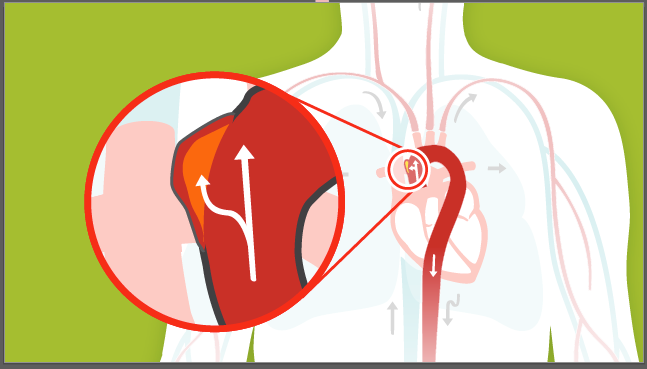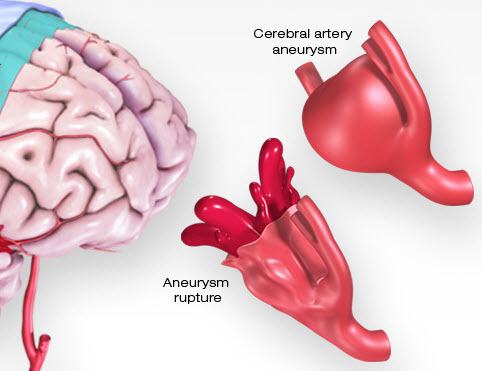Types of Aneurysms
Abdominal aortic aneurysm

An abdominal aortic aneurysm (AAA) occurs when the large blood vessel (the aorta) that supplies blood to the abdomen, pelvis and legs becomes weakened, enlarged or balloons outward. This type of aneurysm occurs most often in older men who have at least one or more risk factor, including emphysema, family history, high blood pressure, high cholesterol, smoking, and possibly, obesity. Women with an AAA generally suffer ruptures more often and with smaller sizes of aneurysms.
The rupture of an abdominal aortic aneurysm is a medical emergency. Call 911 and seek medical attention right away if you or someone you know has extreme pain in the belly or back that doesn't go away. Learn more about this type of aneurysm.
Cerebral aneurysm

Cerebral aneurysms, which affect about 3% to 5% of the U.S. population, occur when the wall of a blood vessel in the brain becomes weakened and bulges or balloons out. The three types of cerebral aneurysms are: berry (saccular), fusiform and mycotic.
The berry aneurysm is the most common and occurs more often in adults. It can range in size from a few millimeters to more than two centimeters. A family history of aneurysms may increase your risk.
Conditions that injure or weaken the walls of the blood vessel, including atherosclerosis, trauma or infection, may also cause cerebral aneurysms. Other risk factors include polycystic kidney disease, narrowing of the aorta and endocarditis.
Like other types of aneurysms, cerebral aneurysms may not have any symptoms. But symptoms may include:
- Severe headache
- Pain above and behind the eye
- Numbness
- Weakness
- Paralysis on one side of the face
- A dilated pupil in the eye
- Vision changes or double vision
- Nausea or vomiting
- Stiff neck
- Sensitivity to light
- Seizures
- Loss of consciousness (brief or prolonged)
- Cardiac arrest
A ruptured cerebral aneurysm is a medical emergency. Call 911 and seek medical attention right away if you or someone you know has symptoms. Learn more about cerebral aneurysms.
Thoracic aortic aneurysm
A thoracic aortic aneurysm is an abnormal bulging or ballooning of the part of the aorta that passes through the chest down to the diaphragm. A common cause is atherosclerosis, or hardening of the arteries.
Other risk factors include:
- Male gender
- Aging
- Hypertension
- Chronic obstructive pulmonary disease
- Smoking
- Previous aortic dissection
- Genetic conditions, such as Marfan syndrome
- Inflammation of the aorta
- Injury from chest wall trauma
- Infections, such as syphilis and tuberculosis
A person with an aneurysm may not experience any symptoms until the aneurysm begins to expand or “leak” blood into nearby tissue.
Symptoms of a thoracic aortic aneurysm may include:
- Hoarseness
- Swallowing problems
- High-pitched breathing
- Swelling in the neck
- Chest or upper back pain
- Clammy skin
- Nausea and vomiting
- Rapid heart rate
- Sense of impending doom
A ruptured thoracic aortic aneurysm is a medical emergency. Call 911 and seek medical attention right away if you or someone you know has symptoms. Learn more about this type of aneurysm.





